Face-Off: Gears of War 4
A technological masterpiece for both Xbox One and PC.
In development since 2014, Gears of War 4 marks the triumphant return of the chainsaw-wielding franchise. While it may seem like familiar ground initially, Gears of War 4 is actually a game of many firsts - it's the first project from The Coalition - the Gears focused studio formerly known as Black Tusk - the first big AAA console game powered by Unreal Engine 4, and the first Gears title released day and date on both Xbox One and PC.
Gears of War is certainly an important franchise for the Xbox platform and it has quite the heritage on the technology side of things. The original game helped influence the amount of memory included in Xbox 360 while simultaneously showcasing Unreal Engine 3 at its best, helping it to become the most popular toolset of the last console generation. Times have changed as of late with more studios favoring in-house solutions but Epic has continued to refine its latest iteration of the technology, Unreal Engine 4. Now, 10 years after the original release, does this latest iteration keep the Gears tradition of pushing technological boundaries alive?
Let's start with the basics - Gears of War 4 is focused on delivering pristine image quality on both platforms. On Xbox One, the game presents a full 1080p resolution for most of the experience while using an adaptive pixel count on the horizontal axis in order to counteract GPU spikes. While playing the campaign or engaging with the game's horde mode (both of which operates at 30 frames per second) you can expect to see full 1080p more than 94 per cent of the time. In competitive multiplayer mode, however, the frame-rate is bumped up to 60fps resulting in more noticeable drops in clarity as the action heats up.
Thankfully, this is backed by Unreal Engine 4's best-in-class temporal anti-aliasing solution, which creates a somewhat soft but remarkably clean image that is temporally stable. In addition, the team makes use of composite texture maps for all roughness textures, helping to avoid distant in-surface aliasing as you move down the mip-map chain. Speaking of mip-maps, the Xbox One version uses an adequate level of texture filtering throughout leading to crisp surfaces at oblique angles. In practice, this means we're looking at the cleanest image quality we've seen on Xbox One.
Should you prefer an even more refined image, the PC version of Gears 4 has you covered with one of the most robust options menus we've seen in a modern PC game. It's possible to select resolutions as high as your current desktop settings while increasing overall visual quality beyond what you can experience on Xbox One. There's a vast number of settings available, but the main takeaway here is that this is a highly optimised port that takes full advantage of the platform - a huge improvement over the disappointing release of Gears of War Ultimate Edition earlier this year.
Performance is also important in a game like this and, as noted above, Gears of War 4 targets 30 frames per second for the campaign and Horde mode alike while aiming instead for 60fps in competitive multiplayer mode on Xbox One. It's a split that has become increasingly common this generation and it works well here. Thanks to its adaptive resolution scaling, the Xbox One manages to avoid bottlenecking the GPU to the point where slowdown rarely occurs resulting in an almost completely locked campaign experience. The same goes for Horde mode 3.0, which delivers a steady 30fps experience throughout. Some users have reported bouts of slowdown in select instances but, having run through hours of captured footage, we encountered no extended performance issues at all. We also tested the game on both an original Xbox One and an Xbox One S - both are rock solid.
The competitive multiplayer focuses on that 60fps update and is very successful in achieving that. When performance falls short, we did run into mild screen tearing along the top portion of the image but, by and large, it's very steady. What's impressive here is just how much it has improved since the original beta test version earlier in the year. Every map has been visually overhauled while simultaneously running much faster all around. We should also mention that Gears of War 4 features snappy loading times on Xbox One, even on campaign respawns. There's nothing more frustrating than waiting 30 or more seconds to retry a difficult section and, thankfully, Gears of War 4 requires between just five and 15 seconds depending on where you died.
If you're running the PC version, you can expect even better results. With the exception of Killer Instinct, the Universal Windows Platform has a very poor track record when it comes to high performance gaming but Gears of War 4 bucks that trend. This is one of the best performing PC ports in recent memory. Based on our own tests and those conducted by many other users, it's a very scalable game that can play well on just about any DX12 capable card. Hitting 60fps is a piece of cake even with mid-range cards such as the R9 290X and GTX 970 while lower end cards, such as the GTX 750 Ti and the Radeon 7850 turn in playable performance.
The real beauty of the PC version lies in its exhaustive list of options. There are settings coming out of settings here to the point where we may actually be looking at overkill here. So in an attempt to break this menu down into a comprehensible chunk of information, we've grouped them by category below while stacking them up against the Xbox One version.
General settings/texture settins
The initial grouping of settings available in Gears of War 4 cover most of the basics including rendering resolution, frame-rate limit, vertical sync and the field of view. As a UWP title, Gears 4 defaults to the resolution of your desktop but the scaled resolution option allows you to adjust this based on your GPU capabilities. If you want to use Nvidia DSR, you'll need to set your desktop to the desired resolution first.
Beyond that, it's also possible to run with an unlimited frame-rate or cap your performance at a variety of frame-rates which is necessary for the adaptive resolution scaling feature. The ability to configure the FOV is a feature that PC gamers expect and Gears 4 does offer this option. The game defaults to 80, which is equivalent to the Xbox One version, but it can be bumped all the way up to 100.
Gears of War 4 also includes several unique settings for handling texture quality. We presume these settings are broken out in this fashion in order to allow GPUs with less available VRAM to spend the available memory as the user sees fit. If you'd prefer to focus on higher resolution scenery textures at the expense of character detail, you can do it. The memory requirements are somewhat steep, however, with the lower settings still eating up over 2GB of VRAM in our tests.

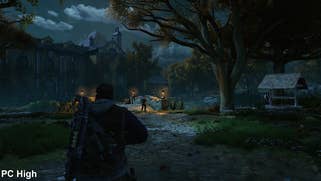




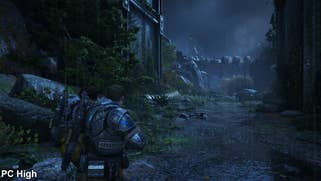

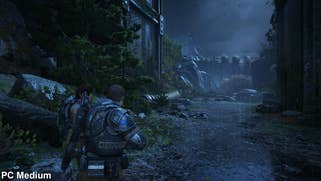
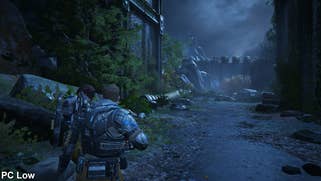
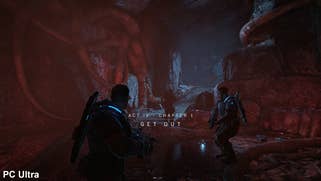
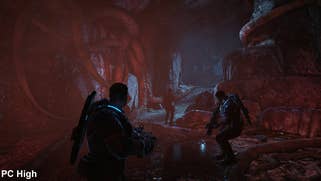
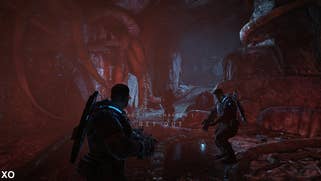
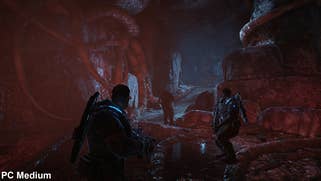
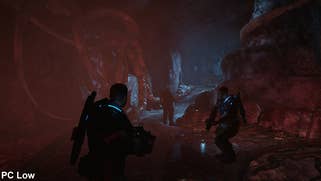
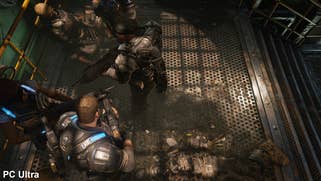
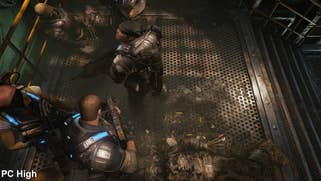


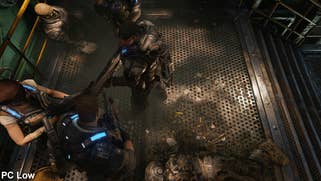
As far as the individual settings are concerned, character texture detail influences the texture resolution of the character models themselves as well as other objects such as weapons, vehicles and the like. World texture detail impacts the resolution of environmental textures and layers associated with these textures - this is the most important setting in regards to texture detail, we feel.
Lighting and effects texture detail focus on the resolution of the game's light maps as well as the quality of select fire textures and other similar effects. World and character detail have the most dramatic impact on visual quality and also require the most memory to the point where 6gb of memory is recommended for the highest settings. Based on our testing, it would appear that Xbox One comes in around the high setting for each of these options with textures that are a great fit for 1080p.
Visual settings
This category focuses primarily on overall level of detail and the quality of the post-processing effects used throughout the game. First we have anti-aliasing quality which determines the precision with which the temporal anti-aliasing solution is rendered. When using higher settings, temporal stability is increased preventing thin objects, such as leaves, from shimmering in motion. All settings retain the same level of edge coverage which can be modified instead by the temporal AA sharpening option. These settings have a minimal impact on performance and, as such, we recommend using the highest possible anti-aliasing quality with your own desired level of temporal sharpening. The differences are extremely subtle to the point where it's not clear where Xbox One falls but it does appear to at least match the high setting.
Motion blur is also included in this category. Unreal Engine 4 includes support for extremely high quality per-pixel motion blur and the results in Gears are expectedly solid. Increasing the value for this setting appears to modify the number of samples used when rendering this effect with the ultra option exhibiting minimal artefacts. Xbox One appears to use the high setting, which is made evident by additional artefacts in motion. Those that dislike motion blur can disable the feature entirely but Gears does appear to use a higher shutter speed here and the effect is significantly less noticeable than in many other games.
Lastly we have a selection of settings which determine the overall detail level on display. World level of detail directly influences the number of extraneous objects scattered around the environment but the difference is actually quite subtle and usually limited to things like piles of rubble, trees, and other such details. Due to the minimal performance cost, it's recommended to stick with ultra or high settings.
Character level of detail determines the complexity of characters within the scene. Modifying this setting impacts how many on-screen characters will be displayed at full detail. At the lowest setting, for instance, only the player character is displayed at full detail. That said, in practice, the difference is incredibly subtle as is the performance cost. The final setting in this group is foliage draw distance which controls, of course, how much visible foliage is presented on screen. Interestingly, Xbox One seems to use a custom value here with results closer to the high setting but still falling short in a few areas.
Lighting and shadows
The first half of this cluster focuses on lighting the game world with options such as light shaft quality, light scattering quality and bloom quality. Gears 4 sports both screen-space style light shafts and true volume lights. The quality of the light shafts, often referred to as crepuscular rays, are used at various junctions throughout the game and can be completely disabled if desired. Increasing this setting simply improves the depth and quality of the individual rays and, on Xbox One, we're looking at the high setting once again. Once you drop to the medium setting the quality of the rays drop off significantly but, with minimal impact on frame-rate, it shouldn't a problem to stick with the higher settings here.
Then we have light scattering quality, which controls the volumetric lighting used in various portions of the game. Increasing this option improves the precision of the effect resulting in cleaner results without additional artefacting along its edges. Xbox One actually appears to use the medium option here, which still looks quite nice, but lacks some of the precision of the higher quality settings. Bloom and lens flare quality are two rather subtle options, then, that influence the intensity of said effects and both of these appear to operate at the high setting on Xbox One.
When it comes to shadows, Gears 4 leverages the strengths of Unreal Engine 4 in order to present very high quality shadow representation, even on Xbox One. The first setting focuses on the resolution of the shadow maps and the number of dynamic shadows used throughout the game and is pretty typical for a modern release. Impressively, the Xbox One version is actually a match for the ultra settings on PC which was an unexpected surprise but there is a reason for it, as we'll touch on shortly.
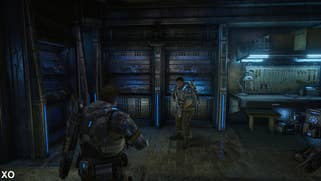
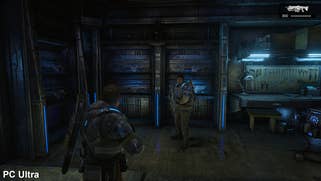
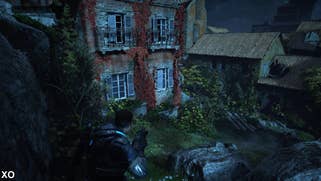
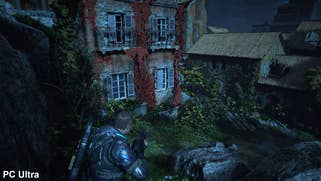
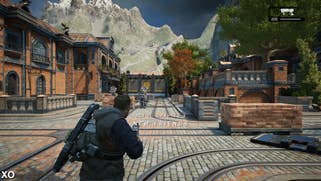
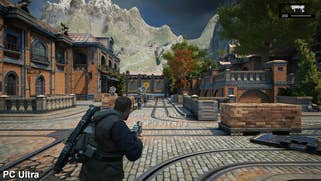

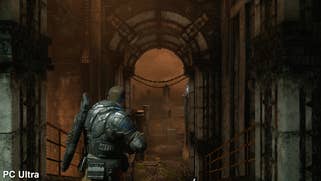
Capsule shadows are another nice feature and something that was introduced in Unreal Engine 4.11. Essentially, these act as indirect shadows which help root characters more firmly in the scene. The high and ultra settings produce the same quality of capsule shadows but the former limits the number of characters per scene using the higher quality effect. Xbox One appears to be a match for the high setting. When you drop down to the medium setting, the quality is greatly impacted while off simply disables them completely.
Then we have screen space shadows, which are incredibly smart addition to the engine, helping to improve performance and fidelity at the same time. Essentially, this technique is designed to solve the problem of rendering detailed shadows for finely detail objects such as grass and foliage. When using shadow maps, the GPU tends to struggle with the large volume of draw calls and depth buffer overdraw but these issues can be avoided by relying instead on screen space shadows for these finer details. By coupling this technique with traditional cascaded shadow maps, the overall demand of the shadow maps can be decreased since they are not used in these more demanding situations. We believe that this technique has allowed the team to make use of higher quality shadow maps on Xbox One.
Lastly, we have the all-important ambient occlusion which is designed to handle contact shadows throughout the scene, as usual. Some of this information is actually baked into materials which is combined with real-time ambient occlusion to create a more cohesive looking scene. This is also one of the more demanding settings on the PC and using the ultra option certainly impacts performance especially when attempting higher resolutions. High produces excellent results, however, and is much less expensive. Xbox One is interesting in that it doesn't appear to completely match any of these results on the PC with very subtle differences in coverage. We'd peg it somewhere between high and medium but it's not entirely clear. On PC you can also adjust the intensity of the ambient occlusion effect which basically controls the strength of the contact shadows.
Advanced visuals
This section of the settings focuses on post-process effects and various other visual niceties starting with post-process quality itself. This seems to be related to eye adaptation, which simulates the behavior of your eye when moving between dark and bright regions of the map. There is almost no perceptible difference between the various settings here but when we move onto the next option, screen-space reflections, we see something entirely different.
Screen space reflections have become a common method for displaying scene accurate reflections with a reasonable performance cost by utilising screen space information. The downside is that, when relevant data is occluded from view, the reflections lose the detail as well. We see this same behavior up through the ultra setting as higher settings simply display more refined, complex reflections. After examining a number of different areas, Xbox One appears to fall around the medium quality for this setting. PC users have one additional option, however, in the form of an "insane" setting. By engaging the insane mode, which is not enabled by any of the standard presets, you can enjoy an extremely high quality version of the effect with more realistic blurring and more reflected detail. This comes at a significant performance penalty but it's a nice forward-facing feature.
Environment reflections and refractions are also simple toggles and, yes, these are both active on Xbox One. These settings basically impact the way light plays off of the player's armour, in the case of environment reflections, and the distortion of elements situated beneath the surface of water in regards to refractions. This is followed by the particle spawn rate which determines the density and speed with which new particles, such as leaves flying through the air, are generated. Keep in mind that these particles update at 30Hz. Lastly you can adjust a separate sharpening filtering which allows you to tweak the image to your liking.
Real-time cinematics and advanced settings
There are just two options in this category - depth of field and sub-surface scattering. Depth of field controls the quality of the associated effect and is used exclusively in real-time cut-scenes. Xbox One appears to fall around the high setting but each of these options works as expected. There is a visible dithering artefact visible across each of these settings until you reach the PC exclusive 'insane' option. As with the screen space reflections, selecting this advanced option has a significant impact on both performance and visual quality. When engaged, depth of field is rendered at a much higher quality with all previous artefacts eliminated in favor of a cleaner effect.
Sub-surface scattering, then, simply determines the quality of light playing off of skin and other fleshy materials. Xbox One appears to utilise the high setting here and the results do look excellent during the real-time cutscenes. It is disappointing that the effect is absent during gameplay and it would have been nice to see as an option for PC users but you won't often see your character's face during gameplay, so it's not a massive issue.
We've finally reached our last group of settings and here we see a few special features that are not particularly common on PC. The first is dynamic resolution scaling, which is enabled on Xbox One. This setting simply attempts to intercept spikes on the GPU and lower the rendering resolution accordingly to prevent additional slowdown from manifesting. The slider below this setting determines the degree to which the resolution is dropped. When playing at 1440p, for instance, a slider set to +33 will allow the game to drop as low as 1080p when performance falters. In order to activate this setting, however, players must cap the frame-rate at one of the available choices in the previous menu.
Lastly, we have tiled resources and async compute. Both of these features are more advanced DirectX techniques designed to improve performance. Tiled resources essentially focuses on bundling larger resources together in a way that saves memory while still remaining accessible for the GPU. Async compute is focused on allowing tasks to execute as needed rather than in order on the GPU. This option only appears if your GPU is actually capable of using it which means all non-Pascal Nvidia cards will not even see this option in the menu. Xbox One, of course, makes use of these features to improve performance.
As you can see from this exhaustive list, Gears of War 4 features an options menu which gives Serious Sam 3 a run for its money. The PC version also features an excellent benchmark feature with incredibly detailed results that can prove quite entertaining in and of itself. Between the copious amount of options and the fantastic performance it's safe to say that Gears of War 4 on the PC is truly a remarkable port.
As solid as this release is, we do have a few nitpicks to mention here. For one thing, the game utilises a mix of real-time and pre-rendered cutscenes, like many other titles, but we feel it relies too heavily on pre-rendered sequences in many cases, which can prove jarring on PC when jumping between higher resolutions and frame-rates down to lower bitrate 1080p video. The greater issue here stems from the poor video playback on PC - all pre-rendered cinematics are displayed with severe frame-pacing artefacts leading to very inconsistent playback. The Xbox One version suffers from no such problem and delivers completely smooth playback in comparison. We'd like to see this issue addressed at some point.
It's also disappointing that the excellent HDR mode available to Xbox One S users is not included with the PC version. Granted, there currently are no PC games supporting this feature, but many of us do play PC games on HDR-ready displays and would love to have this option. It's a great feature which adds to the richness of the visuals. Hopefully we'll see it one day.
Lastly, we have the fire and particles, which were designed for 30fps playback. When playing Gears at frame-rates higher than 30fps, you'll notice that these effects update at a lower rate. It's most noticeable in the few areas which rely on fire effects and those which toss feature blowing leaves all around the player. If you lower the particle spawn rate you can remove these effects from the game but that's hardly a solution here. It's the one visual blemish on an otherwise stunning PC port.
Gears of War 4 - the Digital Foundry verdict
Ultimately, there are is a lot to take away from this experience here. On Xbox One, this is one of the most technically accomplished titles yet released for the platform. With impeccable image quality, steady performance, and a whole host of modern visual effects, it's truly one of the best looking games on the console. We're eager to see how this version of the game is transformed for the arrival of Scorpio next year as well.
The PC version impresses even more due in part to the poor track record of UWP ports this year. Gears of War 4 on the PC runs like a dream on a wide variety of platforms and features one of the most robust set of options we've seen as of late. The Xbox Play Anywhere feature also works supremely well making it possible to switch back and forth seamlessly between PC and Xbox One gameplay. The saves carry right over and all of the messaging is clear so you're never left wondering if your progress will be overwritten.
Gears 4 also marks a high point for Epic's Unreal Engine 4, which had yet to be featured in a big budget AAA experience until now. This remarkable engine has played a key role in allowing The Coalition to deliver a beautiful, highly optimised release on a grand scale. There's little doubt that Gears of 4 lives up to its predecessors. While the visuals may not impress quite as much as Gears of War in 2006, which came at a time when graphics techniques were shifting dramatically, it's still remarkably impressive all around.
Overall then, The Coalition has delivered in spades. Gears of War 4 hits all the right marks and the end results are beautiful to behold. If you choose to buy the game digitally, the Play Anywhere feature means that you don't even need to choose which version you'd like to play as both are included. It's been a strong year for Microsoft's first party studios but Gears of War 4 might just be its best release yet.





















